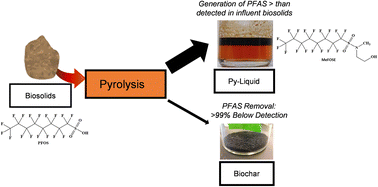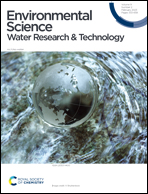Pyrolysis transports, and transforms, PFAS from biosolids to py-liquid†
Abstract
Per- and poly-fluoroalkyl substances (PFAS) in wastewater solids have resulted in bans on land application of biosolids, causing utilities to explore thermal treatment options. Pyrolysis is a thermal treatment process that converts wastewater solids to biochar, py-liquid (i.e., aqueous phase liquid and non-aqueous phase liquid), and py-gas. Research on the impact of pyrolysis on PFAS in biosolids has yielded mixed results, and no research has investigated if PFAS are present in the py-liquid. The goals of this research were to determine if pyrolysis releases PFAS with the effluent py-liquid and to distinguish “removal” from “transformation” of PFAS. Triplicate batch pyrolysis experiments were performed at 500 °C, 650 °C, and 800 °C. Targeted PFAS were analyzed in biosolids, biochar, and py-liquid via LC-MS/MS, and PFAS precursor compounds were measured in the biosolids and biochar using the total oxidizable precursor assay. Pyrolysis removed all targeted PFAS from resulting biochars, with the one exception of perfluorobutanoic acid (PFBA) being present slightly above detection limit in one of the 800 °C biochar samples. PFAS precursor compounds were not detected in five of the nine biochar samples, and the other four biochar samples had only perfluoropentanoic acid (PFPeA) detected slightly above detection limit. Overall, pyrolysis removed >99% of targeted PFAS and PFAS precursor compounds from the solid phase. Interestingly, the mass of N-ethyl perfluorooctane sulfonamidoethanol (NEtFOSE), and N-methyl perfluorooctane sulfonamidoethanol (NMeFOSE) increased by over two orders of magnitude in the effluent py-liquid compared to the influent biosolids. This phenomenon occurred at all three temperatures tested. Similarly, the mass of PFBA also substantially increased following pyrolysis due either to the thermal breakdown of higher chain PFAS, the transformation of PFBA precursor compounds, or a combination of both. These key findings illuminate that pyrolysis of biosolids can cause transformation reactions that lead to specific PFAS in the effluent py-liquid found at higher levels than in the influent biosolids. Overall, this research indicates that pyrolysis could be employed to remove PFAS from biosolids to generate a value-added biochar product for soil amendment benefits, but py-liquid that contains PFAS could also be generated.

- This article is part of the themed collection: PFAS: cleaning up drinking water


 Please wait while we load your content...
Please wait while we load your content...